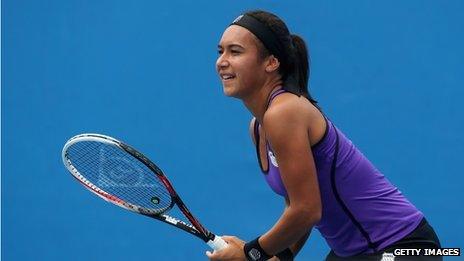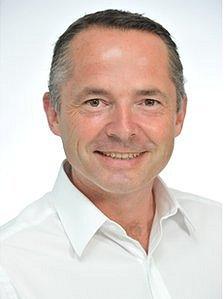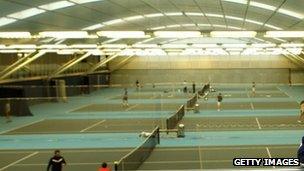Selling British tennis to new grass-roots generation
- Published

British women's number one player Heather Watson
Despite Andy Murray's defeat in the Australian Open final, British elite tennis is in its best health for decades.
US Open champion Murray is the UK's first grand-slam winner since before the war, while Laura Robson and Heather Watson are the first pair of British women to play in the world top 50 at the same time since Jo Durie and Sara Gomer 25 years ago.
Murray and Robson also won medals at the London 2012 Olympics, and Jonny Marray was a surprise winner in the men's doubles tournament at Wimbledon
But developing a British tennis elite is only one part of the brief for governing body, the Lawn Tennis Association (LTA).
An equally important part is the LTA's drive to increase grass-roots participation, a quest given extra focus by demands from funding body Sport England to see tangible results in this area.
Two sides
This is where Simon Long comes in. He is now six months into his job as the LTA's commercial supremo, charged with driving the direction and development of both the LTA's participation and commercial strategies.

Simon Long has a strong background in the business of sport
"The LTA more or less split in two - [an elite] performance side, and one of engagement with the consumer and playing side," says Mr Long, who has much experience in the sports business world.
"We are establishing tennis as a game for everyone. That means getting more people playing tennis, watching tennis, and playing and competing more often.
"We are looking at how we can accelerate that growth."
He was formerly boss of North One Sport, where he oversaw the global promotion of the FIA World Rally Championship.
"We want to get people physically and emotionally involved with tennis, whether it be playing, or watching, or through the LTA's website," he says.
He adds that part of his task is building a "scorecard" showing the different contexts in which people engage with the sport, from top talent and performance metrics at one end of the scale to social media interaction by fans at the other.
Some of the new participation initiatives include cardio-tennis, for people who want to use the sport as a fitness workout, and installing omni-courts featuring artificial grass.
For children, there are mini-tennis courts in place across the country, introducing them to a form of the game more suited to their physical development.
'Competitive marketplace'
Meanwhile, Mr Long points out that there was an 18% growth in weekly tennis participation last year.
And Sport England agrees that "frequency of participation has increased" over the past 12 months.

British tennis success over the past year is being used to sell the sport
However for its funding purposes, it measures participation against a baseline of participation in 2007.
And it has said that it may reduce the amount of cash for tennis that it allocates to the LTA, if there is not a further increase in participation.
"We are stepping back from the coalface to look at what consumers want and to consider how people use their time in terms of sporting activity," says Mr Long.
"Sport England is an important source of funding for us. We are actively working with them.
"We realise we haven't got everything right. But it is a very competitive [leisure] marketplace."
He says the LTA's goal is "to get a better return on resources, time and money."
One of the way to leverage interest in the sport is to use the examples of those British players who have brought the sport into the limelight in the past 12 months.
"We are already working with the leading players. The success of Andy Murray, Laura, Heather... and others, is a fantastic beacon... driving media coverage," says Mr Long.
"We are lucky to be on the cusp of golden era of British tennis, with not only success at the US Open but also at Olympics and Paralympics
"But we are a grass roots as much as an elite organisation, and we are trying to combine the two in a cohesive way."
'Positive perceptions'
As part of the grass roots initiative, the LTA is looking to reach communities - for example in inner cities - that may not normally play tennis.
Part of that programme involves hiring coaches from the local community, and providing courts and floodlighting, with more than £30m spent on facilities over the past five years.
"I am not going to pretend that we have totally cracked this - there are positive perceptions about British tennis and some more challenging ones," he says, referring to the fact that some may incorrectly see tennis as a middle-class sport.
He said a lot of work was being done through the country's largest tennis charity, the Tennis Foundation, in terms of promoting the sport through community work, and with disabled people and in schools.
"Mini-tennis is creating a pathway into the game," says Mr Long, who is based at the LTA's national tennis centre at Roehampton, south-west London.
"And whether you want to play in tournaments, or just play with friends, we are providing a wholesome and safe environment."
'Road-map'
As part of his commercial brief, Mr Long, a former sales development director at Diageo, welcomed new sponsors to the LTA in 2012, including Moet & Chandon, Optimum Nutrition, and Ricoh.
And LTA Group turnover increased from £57.7m to £60.2m in 2012.

The LTA is looking to get people of all ages to play more tennis
During the year the LTA and Tennis Foundation jointly invested £73.2m to grow and sustain British tennis, up from £69.5m in 2011.
Now Mr Long is looking forward to implementing the final phase of the LTA's 10-year plan for the game in the UK over the coming year.
"It is a well-articulated road map about how we transform the sport and organisation," he says.
"The foundations are now in place... [including] an incredibly strong board and governance structure.
"We are now in a position where we can proactively look to the next phase of really engaging with players and fans - from the ages of three to 83 - up and down the country.
"We are in good shape but in no way complacent."